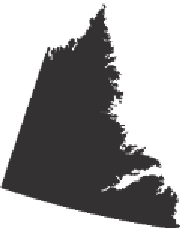Geoscience Reference
In-Depth Information
Greenland
Cap
e
Fa
re
well
0
5
10
15
20
25
30
35
40
45
50
Figure 8.3.
Winds speeds in m s
−1
(see color bar) and wind direction (vectors) for a
forward Greenland tip jet event that occurred on December 5, 2002, based on data from
the NOAA QuikSCAT satellite (courtesy of Kjetil Våge, Woods Hole Oceanographic
Institute, Woods Hole, MA). (See plate section for color version.)
topography of the coast and the synoptic scale wind flow. The frequency of westerly
tip jets is higher when NAO is in its positive phase and lower when the NAO is in its
negative phase. The frequency of northeasterly tip jets shows the opposite relation-
ship with the NAO (Moore
2003
).
Westerly Greenland tip jets tend to occur when a deep synoptic-scale cyclone,
moving along the North Atlantic cyclone track, is located off the southeast coast
of Greenland. The strong tip jet winds result in intense air-sea interaction, which
appears to be able to initiate deep ocean convection in the Irminger Sea (Pickart
et al.,
2003
). J. Doyle and M. Shapiro (
1999
) argued for two mechanisms to explain
the westerly tip jet: (1) conservation of the Bernoulli function, which is the sum of
enthalpy, kinetic energy, and potential energy per unit mass; and (2) Flow around the
barrier of southern Greenland. Which process operates is determined by the com-
bination of wind speed (U) normal to the barrier, atmospheric stability expressed
in terms of the Brunt-Vaisala frequency (N), and the height of the barrier (H), as
expressed in the Froude number:
F =U/NH
(8.1)
If the Froude number (F) is greater than 1, air can surmount the barrier of south-
ern Greenland. Through conservation of the Bernoulli function, air will accelerate










































































































































































































































































































































































































































































































































































































































































































































































































































































































































































































































































































































































































































































































































































































































































































































































































































































































































































































































































































































































































































































































































































































































































































































































































































































































































































































































































































































































































































































































































































































































































































































































































































































































































































































































































































































































































































































































































































































































































































































































































































































































































































































































































































































































































































































































































































































































































































































































































































































































































































































































































































































































































































































































































































































































































































































































































































































































































































































































































































































































































































































































































































































































































































































































































































































































































































































































































































































































































































































































































































































































































































































































































































































































































































































































































































































































































































































































































































































































































































































































































































































































































































































































































































































































































































































































































































































































































































































































































































































































































































































































































































































































































































































































































































































































































































































































































































































































































































































































































































































































































































































































































































































































































































































































































































































































































































































































































































































































































































































































































































































































































































































































































































































































































